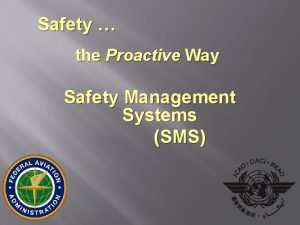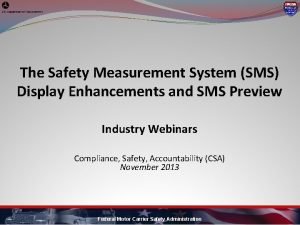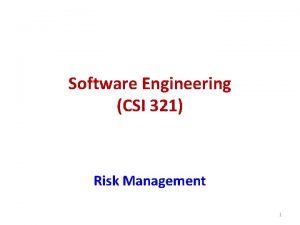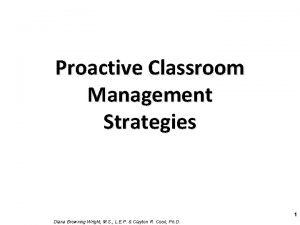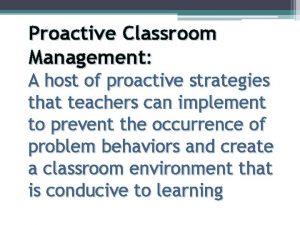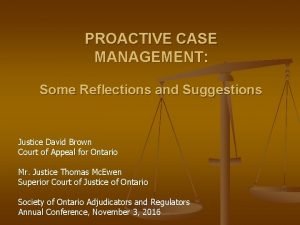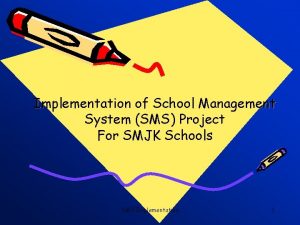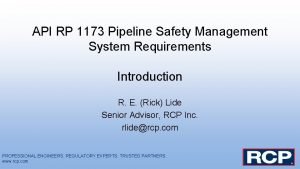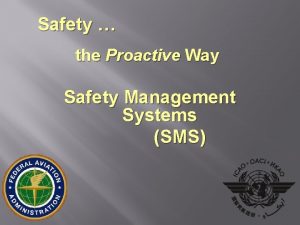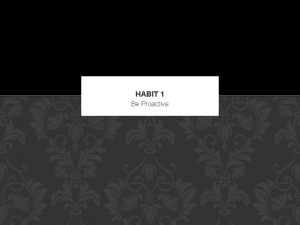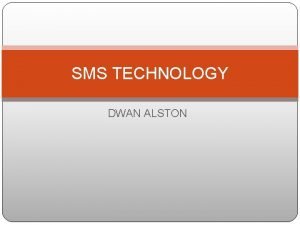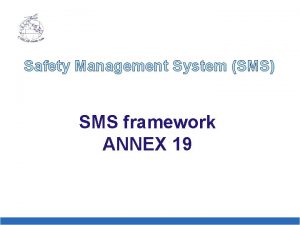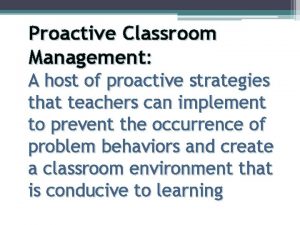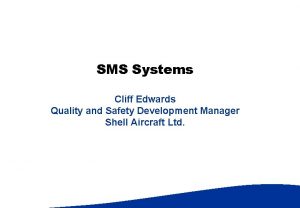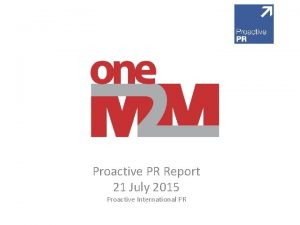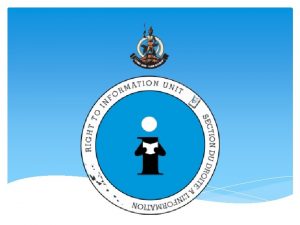Safety the Proactive Way Safety Management Systems SMS




























- Slides: 28

Safety … the Proactive Way Safety Management Systems (SMS)

Two Wise Men…. “If you keep doing what you’re doing… you’re going to keep getting what you got!” Yogi Berra Insanity: doing the same thing over and over again and expecting different results. Albert Einstein, (attributed)

An Industry Answer? Aviation Safety to Fire Operations Safety SMS Launching a common idea and a new approach:

“SMS” A systematic and continuous Management process based on proactive identification of Hazards, and analyses of their Risk

SMS requires knowledge of Human Error Mechanisms Human Error accounts for 60 -80% of all Aviation Accidents. SMS is about managing the manageable, so it requires knowledge of how, what, and why human errors occur.

SMS IS BUILT AROUND FOUR PILLARS

• POLICY • Doctrine • Practices • Principles • Risk Management • Proactive SAFETY CULTURE • Prevention • Assurance • Reporting • Investigations • Audits • Promotion • Learning • Communication • Training • Reporting • Quality Assurance

SMS Features v Systematic – Safety management activities are in accordance with a pre-determined plan, and applied in a consistent manner throughout the organization. v Proactive – An approach that emphasizes hazard identification and risk control and mitigation, before events that affect safety occur. v Explicit – All safety management activities are documented and visible.

Organizational Failure Model Professor James Reason, University of Manchester Organizational factors Unsafe supervision Preconditions for unsafe acts Unsafe acts

“Active Failures” Professor James Reason, University of Manchester Those errors and violations having an immediate adverse effect

Latent Conditions… …may lie dormant for a long time, and only become evident when they combine with a triggering mechanism to breach the system’s defenses

The Path to Latent Conditions Latent conditions can be created by: Ø Corporate climate and values Ø How corporate decisions are made Ø Corporate priorities Ø Who influences the decision-making chain Ø How the decision-making process is recorded and performance tracked Ø Not measuring results against expectations

Problems and Solution �Current safety approaches can’t keep up with complexity growth �We need a new approach for our safety management and oversight problems

A SMS Organization… Develops a “Just culture” or “Safety Culture” to: ü Capture the operational knowledge and experience of the employees ü Involve the employees in the safety achievement process

• Person Model • Name • Blame • Shame • Retrain • Write Another Procedure • Fire the Perpetrator • We Ask Who? • James Reason & Alan Hobbs (2003) System Model Remedial attention focused on the task and the work place • Organization • Supervision • Managing the manageable • We Ask Why?

Aspects of a Positive Safety Culture • Informed culture • Flexible culture • People are knowledgeable about the human, technical, organizational and environmental factors that determine the safety of the system as a whole. • Reporting Culture • People can adapt organizational processes when facing high temporary operations or certain kinds of danger, shifting from the conventional hierarchical mode to a • Learning culture flatter mode. • People have the willingness and the competence to draw conclusions from safety information systems and the will to implement major • James Reason (1997) reforms. • Positive Culture • People are • HRO prepared to report their errors and • experiences Just culture • People are encouraged (even rewarded) for providing essential safety-related information. However, there is a clear line that differentiates between acceptable and unacceptable behaviour.

Just Culture A just culture has a documented disciplinary policy - Define clear lines between the acceptable and the unacceptable • Blame culture promotes hiding • Just culture promotes partnership • A roadmap to a just culture

Three possible organizational cultures • Pathological • Bureaucratic • Generative • Information • Hidden • Ignored • Sought • Messengers • Shouted • Tolerated • Trained • Responsibilities • Shirked • Boxed • Shared • Reports • Discouraged • Allowed • Rewarded • Failures • Covered up • Merciful • Scrutinized • Crushed • Problematic • Resulting • Conflicted • “Red tape” • organization Organization • Welcomed • Highly Reliable Organization • New ideas

The Issue of Focus What do Interagency Aviation Managers want? • A Safe and Efficient safety system

The Iceberg of Ignorance 4% Problems known to top management 9% Problems known to middle/“line” Management 74% Problems known to supervisors 100% Problems known to rank and file MX personnel • Source: Yoshida, Shuichi, 2 nd Intl Quality Symposium, 1989

Cultural Shift The FS and DOI aviation programs are making progress with strategic risk assessments and doctrinal revisions in policy. We are seeing significant support in the ranks as a result of recent field inspections, the use of gap analysis tools in maintenance circles, and the interest at all levels in operational risk management.

SMS…emphasizes Risk Management …It integrates safety with Line Management


A SMS Organization… Adopts Risk Management Practices to: Ø Adapt to change Ø Manage resource application ØUnderstand the pitfalls of the operating environment

Implementing SMS � � � Follows a phased approach The processes underlying the four pillars are modularized “Growth” or “increasing maturity” is emphasized for the system as a whole and its internal processes

“Growing” SMS” 4 The SMS Maturity Steps 3 2 1 0 Reactive Processes Planning & Organization Orientation & Commitment Continuous Improvement Proactive/Predictive Processes

SMS is the toolbox for… • Policy & Management Practices • Safety Assurance processes • Safety promotion practices • Risk Management process

Questions? Contact Ron Hanks USFS at 208 -387 -5607 or Joe Bates BLM 208 -387 -5879
 Sms 4 pillars
Sms 4 pillars Smsapi.pl
Smsapi.pl Sms based poll monitoring system
Sms based poll monitoring system Sms safety management system
Sms safety management system Bulk sms hsn code
Bulk sms hsn code Proactive vs reactive safety
Proactive vs reactive safety Safety measurement system
Safety measurement system Sms safety score
Sms safety score Safety promotion sms
Safety promotion sms A systematic attempt to specify threats to the project plan
A systematic attempt to specify threats to the project plan 17 proactive classroom management strategies
17 proactive classroom management strategies Proactive vs reactive classroom management
Proactive vs reactive classroom management Diana browning
Diana browning Proactive risk management
Proactive risk management Proactive case management
Proactive case management Sms school management system
Sms school management system Phoenix life cycle
Phoenix life cycle Api 1173 pipeline safety management systems
Api 1173 pipeline safety management systems Food safety management systems servsafe chapter 8 notes
Food safety management systems servsafe chapter 8 notes What's a frequency table
What's a frequency table Perbedaan one way dan two way anova
Perbedaan one way dan two way anova Two way threaded binary tree
Two way threaded binary tree Perbedaan anova one way and two way
Perbedaan anova one way and two way Hypothesis for two way anova
Hypothesis for two way anova One way anova vs two way anova
One way anova vs two way anova Two way anova
Two way anova Conventional software engineering
Conventional software engineering Bottle of rum to fill my tum
Bottle of rum to fill my tum Talk this way
Talk this way
